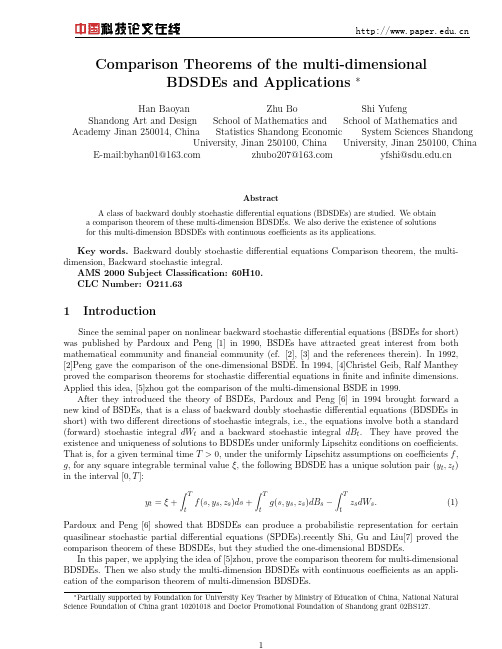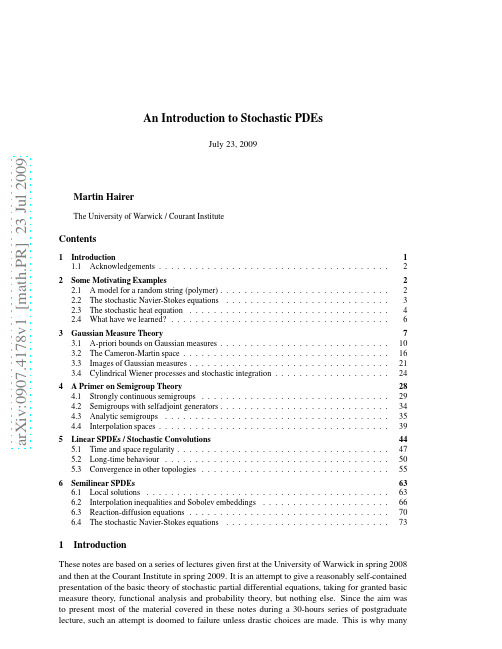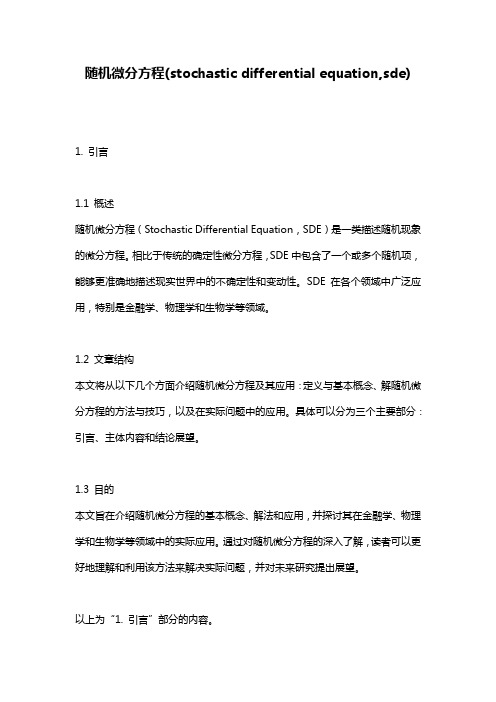正倒向随机微分方程最优控(英文版)(张良泉著)思维导图
最优控制课程课件II-6.LQR和微分博弈

. .. . . ..
13 / 49
从优化到博弈
博弈论基础 博弈论
定义 1 (函数极小值)
Ω ⊂ RN 是开集。称函数 F ∈ C1(Ω) 在 x 达到局部极小值,若存 在 ϵ > 0 使得:
F (x) ≤ F (x′), if ∥x′ − x∥ < ϵ, ∀x′ ∈ Ω.
定义 2 (纳什平衡 Nash Equilibrium, NE)
最优控制的数学理论
. .. . . ..
10 / 49
博弈论基础 一个例子
引入“相对位置”“相对速度”
令 x := xM − xT , v := vM − vT . 状态方程变为
x˙ = vM − vT = v,
(14)
v˙ = uM − uT .
(15)
终值条件 x(tf ) = 0, v(tf ) free。性能指标不变
1951 年起,Rand 公司在美国空军资助下,Rufus Issacs 研究 对抗双方都能自由决策行动的追逃问题,形成了微分博弈的 最初研究成果
60-70 年代,微分博弈理论逐渐完善,得到微分博弈值函数 存在性等基础结果;1965 年,Issacs 整理出版了第一部微分 博弈同名专著。也称动态博弈
最优控制的数学理论
. .. . . ..
15 / 49
博弈论基础 反应函数法求解纳什平衡
古诺博弈: 反应函数法求解纳什平衡
例 3 (古诺寡头竞争模型, Cournot Model) 两家公司 i = 1, 2 生产同类产品,生产数量为 qi ≥ 0,生产成本为 c(qi) = cqi,市场上产品单价 p(q) = a − q 与市场上的产品总量 q = q1 + q2 有关。
最优控制课件第3章

经典变分法局限性: 1、应用前提: a )控制量 u(t)的取值无约束。 b ) f、L、Φ等函数对其自变量二次连续可微,要求哈密 尔顿函数关于控制变量的偏导数存在 。 2、实际控制要求:
a )控制量u受不等式约束,如:M i (u ) 0 ,i=1,2,3……
b )性能指标有时关于u并不可微,要求哈密尔顿函数 关于控制变量的偏导数不存在 。
一般:对于实际系统根据物理意义有最优解 极小值原理 有唯一解-- 最优解
--------
--------
但是,对于线性系统可以证明极小值原理既是泛函取最小 值的必要条件,也是充分条件。
Optimal Control Theory
Dong Jie 2014. All rights reserved.
Date: File:
05.04.2015 OC_CH3.6
Optimal Control Theory & its Application
②在最优轨线上,与最优控制u*相对应的H函数取绝对极小 值,即 或 沿最优轨线
③H函数在最优轨线终点满足
Optimal Control Theory
Dong Jie 2014. All rights reserved.
Optimal Control Theory & its Application
取哈密尔顿函数为
则实现最优控制的必要条件是,最优控制u*、最优轨线x* 和最优协态矢量λ*满足下列关系式: ①沿最优轨线满足正则方程
当g中不含x时
Optimal Control Theory
Dong Jie 2014. All rights reserved.
最优控制全部PPT课件

J
(x(t f ),t f)
tf t0
F(x(t),u(t),t)dt
为最小。
这就是最优控制问题。
如果问题有解,记为u*(t), t∈ [t0,tf],则u*(t)叫做最优控制(极值控制),相应的轨 线X*(t)称为最优轨线(极值轨线),而性能指标J*=J(u*(·))则称为最优性能指标。
第11页/共184页
目标质心的位置矢量和速度矢量为: xM xM
F(t)为拦截器的推力
x xL xM v xL xM
则拦截器与目标的相对运动方程为:
x v v a(t) F (t)
m(t)
m F (t) c
其中a(t)是除控制加速度外的固有相对加速度,是已知的。
初始条件为: x(t0 ) x0 v(t0 ) v0 m(t0 ) m0 终端条件为: x(t f ) 0 v(t f )任意 m(t f ) me
至于末态时刻,可以事先规定,也可以是未知的。 有时初态也没有完全给定,这时,初态集合可以类似地用初态约束来表示。
第9页/共184页
3:容许控制 在实际控制问题中,大多数控制量受客观条件的限制,只能在一定范围内取 值,这种限制通常可以用如下不等式约束来表示:
0 u(t) umax 或ui i 1,2p
给定一个线性系统,其平衡状态X(0)=0,设计的目的是保持系统处于平衡状态,即 这个系统应能从任何初始状态返回平衡状态。这种系统称为线性调节器。
线性调节器的性能指标为:
J
tf t0
n
xi 2 (t)dt
i 1
加权后的性能指标为:
J
tf t0
n
qi xi 2 (t)dt
i1
对u(t)有约束的性能指标为: J t f 1 [ X T (t)QX (t) uT (t)Ru(t)]dt
高维倒向重随机微分方程的比较定理及其应用

(H2) There exist constants C > 0 and 0 < α < 1 such that for any (ω, t) ∈ Ω × [0, T ], (y1 , z1 ), (y2 , z2 ) ∈ Rk × Rk×d , |f (t, y1 , z1 ) − f (t, y2 , z2 )|2 ≤ C (|y1 − y2 |2 + z1 − z2 2 ) g(t, y1 , z1 ) − g(t, y2 , z2 ) 2 ≤ C |y1 − y2 |2 + α z1 − z2 2 Given ξ ∈ L2 (Ω, FT , P ; Rk ), we consider the following BDSDE:
Comparison Theorems of the multi-dimensional BDSDEs and Applico Shi Yufeng Shandong Art and Design School of Mathematics and School of Mathematics and Academy Jinan 250014, China Statistics Shandong Economic System Sciences Shandong University, Jinan 250100, China University, Jinan 250100, China E-mail:byhan01@ zhubo207@ yfshi@
随机偏微分方程基础教程

4
5
Linear SPDEs / Stochastic Convolutions 5.1 Time and space regularity . . . . . . . . . . . . . . . . . . . . . . . . . . . . . . . . . . . 5.2 Long-time behaviour . . . . . . . . . . . . . . . . . . . . . . . . . . . . . . . . . . . . . 5.3 Convergence in other topologies . . . . . . . . . . . . . . . . . . . . . . . . . . . . . . . Semilinear SPDEs 6.1 Local solutions . . . . . . . . . . . . . . . . . . . 6.2 Interpolation inequalities and Sobolev embeddings 6.3 Reaction-diffusion equations . . . . . . . . . . . . 6.4 The stochastic Navier-Stokes equations . . . . . . . . . . . . . . . . . . . . . . . . . . . . . . . . . . . . . . . . . . . . . . . . . . . . . . . . . . . . . . . . . . . . . . . . . . . . . . . . . . . . . . . . . .
2
S OME M OTIVATING E XAMPLES
coupla-based

Copula-based Multivariate GARCH Model with Uncorrelated Dependent Errors∗Tae-Hwy Lee†University of California,RiversideXiangdong Long‡University of CambridgeFirst version:August2005This version:December2006ABSTRACTMultivariate GARCH(MGARCH)models are usually estimated under multivariate normality. In this paper,for non-elliptically distributedfinancial returns,we propose copula-based multivariate GARCH(C-MGARCH)model with uncorrelated dependent errors,which are generated through a linear combination of dependent random variables.The dependence structure is controlled by a copula function.Our new C-MGARCH model nests a conventional MGARCH model as a special case.The aim of this paper is to model MGARCH for non-normal multivariate distributions using copulas.We model the conditional correlation(by MGARCH)and the remaining dependence(by a copula)separately and simultaneously.We apply this idea to three MGARCH models,namely,the dynamic conditional correlation(DCC)model of Engle(2002),the varying correlation(VC)model of Tse and Tsui(2002),and the BEKK model of Engle and Kroner(1995).Empirical analysis with three foreign exchange rates indicates that the C-MGARCH models outperform DCC,VC, and BEKK in terms of in-sample model selection and out-of-sample multivariate density forecast, and in terms of these criteria the choice of copula functions is more important than the choice of the volatility models.Key Words:Copula,Density forecast,MGARCH,Non-normal multivariate distribution,Uncorre-lated dependent errors.JEL Classification:C3,C5,G0.∗We would like to thank two anonymous referees for very useful comments that have substantially improved the paper.We also thank seminar participants at SETA2005in Taipei,ESWC2005in London,Workshop on Financial Risk and Time Series Analysis in Munich,and FEMES2006in Beijing,for helpful discussions and comments.All errors are our own.†Corresponding author.Department of Economics,University of California,Riverside,CA92521,U.S.A.Tel:+1 (951)827-1509.Fax:+1(951)827-5685.Email:taelee@‡Judge Business School,University of Cambridge,U.K.Tel:+44(1223)760-581.Fax:+44(1223)760-576.Email: xl256@1IntroductionModeling the conditional covariance matrix is in the core offinancial econometrics,as it is crucial for the asset allocation,financial risk management,and derivatives pricing.The multivariate gen-eralized autoregressive conditional heteroskedasticity(MGARCH)models in the literature include the BEKK model by Engle and Kroner(1995),the dynamic conditional correlation(DCC)model by Engel(2002),and the varying correlation(VC)model by Tse and Tsui(2002).However,these models have been estimated under the multivariate normality assumption,while this assumption has been rejected in much of the empiricalfindings—Fama and French(1993),Richardson and Smith(1993),Longin and Solnik(2001),Mashal and Zeevi(2002),among many others.The aim of this paper is to model MGARCH for non-normal multivariate distributions using copulas.We propose a simple new model named a Copula-based Multivariate GARCH model,or in short C-MGARCH model,which permits modeling conditional correlation(by MGARCH)and dependence(by a copula)separately and simultaneously for non-normal multivariate distributions.Our approach is based on a transformation,which removes the linear correlation from the dependent variables to form uncorrelated dependent errors.The dependence structure is controlled by a copula while the correlation is modeled by an MGARCH model.The C-MGARCH model can capture the dependence in the uncorrelated errors ignored by all existing MGARCH models.For every MGARCH model,the corresponding C-MGARCH model can be constructed.Simulation and empirical analysis are conducted to demonstrate the superiority of the new model over existing MGARCH models such as the DCC,the VC,and the BEKK models.The paper takes advantage of both MGARCH models and of copulas.While a number of existing papers have used copulas to model dependence(particularly in the tails)and/or to model non-normality(e.g.,skewness,fat tail),the current paper is thefirst that models MGARCH with copula distributions.The model is therefore able to model the conditional correlations and conditional dependence simultaneously.The paper is organized as follows.Section2provides a brief review on MGARCH models. Section3introduces the new C-MGARCH model with uncorrelated dependent errors.In Section 3,we focus on the bivariate case.Section4considers the multivariate extensions in several different way.Section5conducts empirical analysis for comparison of existing MGARCH models with their corresponding C-MGARCH models in terms of in-sample model selection criteria and out-of-sample (OOS)density predictive ability.The C-MGARCH models outperform corresponding DCC,VC and BEKK models when they are applied to three foreign exchange rates(French Franc,Deutschemark,and Italian Lira).Section6concludes.Section7is Appendix on copulas.2MGARCH ModelsWe begin with a brief review of three MGARCH models.Suppose a vector of the m return series {r t}n t=1with E(r t|F t−1)≡µt=0and E(r t r0t|F t−1)≡H t where F t−1is the information set(σ-field)at time t−1.For simplicity,we assume the conditional meanµt is zero.For H t,many specifications have been proposed.Engle and Kroner(1995)propose the BEKK modelH t=Ω+A(r t−1r0t−1)A0+BH t−1B0,(1) With the scalar or diagonal specifications on A and B,we obtain the scalar BEKK(SBEKK)or the diagonal BEKK.We use the SBEKK in Section5,which isH t=(1−a−b)¯Ω+a(r t−1r0t−1)+b H t−1,(2) where¯Ω=n−1P n t=1r t r0t is the sample covariance matrix of r t.Instead of modeling H t directly,conditional correlation models decompose H t into D t R t D t, where D2t≡diag(H t).As the conditional covariance matrix forεt≡D−1t r t is the conditional correlation matrix for r t,The DCC model of Engle(2002)models Q t,the covariance matrix ofεt, via a variance-targeting scalar BEKK model:Q t=(1−a−b)¯Q+a(εt−1ε0t−1)+b Q t−1,(3) where¯Q is the sample covariance matrix ofˆεt.A transformation R t=diag Q−1t Q t diag Q−1t makes the conditional correlation matrix for r t.The VC model of Tse and Tsui(2002)uses the following specificationR t=(1−a−b)¯R+a˜R t−1+b R t−1,(4)where¯R is the positive definite unconditional correlation matrix with ones in diagonal,and˜R t= P M i=1ε1,t−iε2,t−i/³P M i=1ε21,t−i P M i=1ε22,t−i´1/2.11In Tse and Tsui(2002),a necessary condition to guarantee˜R t positive definite is M>k.Another necessary condition for non-singularity of˜R t,which should be added,is that M should be bigger than the maximum number of observations of consecutive zeros ofεi,t,i=1,...,k.In the empirical section,we set M=5,which is transaction days in one week.3New Model:C-MGARCHIn the vast existing MGARCH literature,the distribution for r t is assumed to be a certain bivariate elliptical distribution(e.g.,bivariate normal or Student’s t)with meanµt(=0)and conditionalr t would then have the same bivariate elliptical covariance H t.The standardized errors e t=H−1/2tdistribution with zero mean and identity covariance:E(e t|F t−1)=0and E(e t e0t|F t−1)=I.How-ever,Embrechts et al.(1999)point out some wide-spread misinterpretations of the correlation,e.g., that no-correlation does not imply independence and a positive correlation does not mean“positive dependence”(Lehmann1966).Here,the identity conditional covariance matrix of e t itself does not imply independence except when e t follows an elliptical distribution.The key point of this paper is that we permit dependence among the elements of e t even if they are uncorrelated as shown by E(e t e0t|F t−1)=I.The C-MGARCH model specifies the dependence structure and the conditional correlation separately and simultaneously.The former is controlled by a copula function and the latter is modeled by an MGARCH model for H t.We use the(similar)notation of Joe(1996).Let F1,···,m denote an m-variate distribution,with continuous univariate margins F1,...,F m.Let F S denote the higher order margins where S is a subset of{1,2,...,m}with cardinality at least2.The densities,when they exist,are denoted as f S.For example,F{1,2}is the bivariate margin of the variable1and variable2with S={1,2}.A simplifying notation without braces for the subset S is used,e.g.,F12≡F{1,2}.For j/∈S, F j|S≡F{j}∪S F S denotes the conditional distribution of variable j given those whose indices are in.The corresponding conditional density(if it exists)is denoted as f j|S.Denote S,e.g.,F1|2=F12F2u i≡F i(ηi)for the probability integral transform ofηi.In Section3we focus on the bivariate case with m=2.In Section4the multivariate cases with m≥2are considered.Before we introduce our new C-MGARCH model,wefirst briefly review the copula theory(with some more details in Appendix).3.1CopulaAlthough there are many univariate distributions used in econometrics,for multivariate distribution there are few competitive candidates besides multivariate normal distribution and multivariate Student’s t distribution.However,the multivariate normal distribution is not consistent with the well-known asymmetry and excess kurtosis infinancial data although it is easy to use.In this paper, we use the recently popular copulas to construct uncorrelated dependent errors.The principle characteristic of a copula function is its ability to decompose the joint distribution into two parts:marginal distributions and dependence structure.Different dependence structures can combine the same marginal distributions into different joint distributions.Similarly,different marginal distributions under the same dependence structure can also lead to different joint distributions. Definition(Copula):A function C:[0,1]2→[0,1]is a copula if it satisfies(i)C(u1,u2)=0for u1=0or u2=0;(ii)P2i=1P2j=1(−1)i+j C(u1,i,u2,j)≥0for all(u1,i,u2,j)in[0,1]2 with u1,1<u1,2and u2,1<u2,2;and(iii)C(u1,1)=u1,C(1,u2)=u2for all u1,u2in[0,1].¥The relationship between a copula and joint distribution function is illuminated by Sklar’s (1959)theorem.Sklar’s Theorem:Let F12be a joint distribution function with margins F1and F2.Then there exists a copula C such that for allη1,η2,F12(η1,η2)=C(F1(η1),F2(η2))=C(u1,u2).(5) Conversely,if C is a copula and F1and F2are marginal distribution functions,then the function F12defined above is a joint distribution function with margins F1and F2.¥The joint density function f12(η1,η2)isf12(η1,η2)=∂2F12(η1,η2)12(6)=∂2C(u1,u2)∂u1∂u2·∂F1(η1)∂η1·∂F2(η2)∂η2=c(F1(η1),F2(η2))·f1(η1)·f2(η2),where the copula density is c(u1,u2)=∂2C(u1,u2)∂u1∂u2.For independent copula C(u1,u2)=u1u2, c(u1,u2)=1.An important property of copula function is its invariance under the increasing and continuous transformation,such as log transformation.The joint survival function¯C(u1,u2)is¯C(u1,u2)=Pr(U1>u2,U2>u2)=1−u1−u2+ C(u1,u2).The survival copula of C(u1,u2)is C S(u1,u2)=u1+u2−1+C(1−u1,1−u2).The joint survival function and the survival copula are related through¯C(u1,u2)=C S(1−u1,1−u2).The density of survival copula can be expressed through the density of original copula as c S(u1,u2)= c(1−u1,1−u2).Upper tail dependenceλU and lower tail dependenceλL defined asλU=lima↑1Pr[η2>F−12(a)|η1>F−11(a)]=lima↑1[1−2a+C(a,a)]1−a,λL=lima↓0Pr[η26F−12(a)|η16F−11(a)]=lima↓0C(a,a),measure the dependence in extreme cases.The tail dependence of each copula is discussed in Appendix.In this paper,we use the independent(I)copula,Gumbel(G)copula,Clayton(C)copula,Frank (F)copula,Gumbel survival(GS)copula,and Clayton survival(CS)copula.Their functional forms and properties are discussed in Appendix.From(6),the log-likelihood function for{ηt}n t=1is:Lη(θ)=nX t=1ln f12(η1,t,η2,t;θ)=nX t=1ln f1(η1,t;θ1)+ln f2(η2,t;θ2)+ln c¡F1(η1,t;θ1),F2(η2,t;θ2);θ3¢(7)where n is the number of the observations andθ=(θ01θ02θ03)0are the parameters in the marginal densities f1(·)and f2(·),and the copula shape parameter.The log-likelihood is decomposed into two parts,thefirst two terms related to the marginals and the last term related to the copula.3.2Related literature using copulaWe note that the MGARCH models discussed in Section2can also be put in the copula framework with elliptical copulas(normal or Student’s t).For example,to estimate for H t=D t R t D t,the DCC model of Engle(2002)assumes the normal margins for elements ofεt=D−1t r t=(ε1,tε2,t)0 and the normal copula for u1,t=Φ(ε1,t;θ1)and u2,t=Φ(ε2,t;θ2)(whereΦ(·)is the univariate normal CDF)with the copula shape parameter being the time-varying conditional correlation R t.2 This is to assume the bivariate normal distribution.Let(θ01θ02)0be parameters in D t,andθ3in R t.The log-likelihood function for the DCC model has the form:L r(θ)=−12nX t=12ln(2π)+r0t H−1t r t+ln|H t|(8)=−1n X t=1¡2ln(2π)+r0t D−2t r t+ln|D t|2¢−1n X t=1¡ln|R t|+ε0t R−1tεt−ε0tεt¢,where thefirst part corresponds to the normal marginal log-likelihood and the second part corre-sponds to the normal copula log-likelihood.See(25)for the normal copula function in Appendix. In this case the margins contain D t and the copula contains R t.To accommodate the deviations from bivariate normality in thefinancial data,there have been other related attempts in the literature that use copulas.However,these works focus on modeling the conditional dependence instead of the conditional correlation.For example,taking the empirical 2However,if non-normal margins are assumed,R t is not the the conditional correlation of r t and H t is not MGARCH of r t.distribution functions for the margins and a parametric function for the copula,Breymann et al.(2003)and Chen and Fan(2006)estimate D2t≡diag(H t)using univariate realized volatilityestimated from high frequency data or using univariate GARCH models.In that framework, estimated are the univariate conditional variances D2t and the conditional dependence,but not the conditional correlation R t nor the conditional covariance H t.The aim of our paper is different than those of the above mentioned papers.We model the conditional covariance H t for non-normal multivariate distributions using copulas.Our model is to separately quantify the conditional correlation(by MGARCH)and the remaining dependence (by copula).We now introduce such a model.The idea is to have the new C-MGARCH model inherited from the existing MGARCH models to model H t,at the same time it is also to capturer t.the remaining dependence in the uncorrelated dependent standardized errors e t=H−1/2t3.3Structure of C-MGARCH modelFor m=2,let r t=(r1,t r2,t)0,ηt=(η1,tη2,t)0,and e t=(e1,t e2,t)0.The C-MGARCH model can be formulated as follows:ηt|F t−1∼F12(η1,t,η2,t;θt),(9)e t=Σ−1/2ηt,tr t=H1/2e t,twhere E(e t|F t−1)=0,E(e t e0t|F t−1)=I,E(ηt|F t−1)=0,and E(ηtη0t|F t−1)=Σt=(σij,t). By the Sklar’s theorem,F12(η1,t,η2,t;θt)=C(F1(η1,t;θ1,t),F2(η2,t;θ2,t);θ3,t),where C(·,·)is the conditional copula function.The conventional approach is to assume bivariate independent normality forηt(C(u1,u2)= u1u2,i.e.,σ12=0),while our approach is to assume a dependent copula forηt keeping e t uncor-related(C(u1,u2)=u1u2).The main contribution of our C-MGARCH model is that it permits modeling the conditional correlation and dependence structure,separately and simultaneously.As the Hoeffding’s(1940)lemma shows,the covariance betweenη1andη2is a function of marginal distributions F1(·)and F2(·),and joint distribution F12(·).See Lehmann(1966),Shea (1983),and Block and Fang(1988).Hoeffding’s Lemma:Letη1andη2be random variables with the marginal distributions F1 and F2and the joint distribution F12.If thefirst and second moments arefinite,thenσ12(θ)=ZZ R2[F12(η1,η2;θ)−F1(η1;θ1)F2(η2;θ2)]dη1dη2.(10)¥By Hoeffding’s Lemma and Sklar’s Theorem,the off-diagonal elementσ12,t of the conditional covariance matrixΣt betweenη1,t andη2,t at time t,can be expressed asσ12,t(θt)=ZZ R2[C(F1(η1;θ1,t),F2(η2;θ2,t);θ3,t)−F1(η1;θ1,t)F2(η2;θ2,t)]dη1dη2.(11) For simplicity,we assume that the marginal standard normal distribution(for whichθ1,θ2are known)and the copula parameterθ3is not time-varying:θt≡θ=θ3.3This makesσ12,t(θt)≡σ12(θ)andΣt(θt)≡Σ(θ).The log-likelihood function for{ηt}n t=1is:Lη(θ)=nX t=1ln f1(η1,t)+ln f2(η2,t)+ln c(F1(η1,t),F2(η2,t);θ).(12)Because r t=H1/2tΣ−1/2ηt,the log-likelihood function for{r t}n t=1is:L r(θ,α)=Lη(θ)+nX t=1ln¯¯¯Σ1/2(θ)H−1/2t(α)¯¯¯,(13)where¯¯¯Σ1/2H−1/2t¯¯¯is the Jacobian of the transformation fromηt to r t,andαis the parameter vector in the MGARCH model for H t(DCC,VC,SBEKK).We maximize L r(θ,α)to estimate all parameters in one step,with the diagonal elements ofΣbeing normalized(σii=1)for identification.Remark1:Because e t=Σ−1/2t ηt,ifΣ−1/2t=Σ−1/2≡(a ij),then e1,t=a11η1,t+a12η2,t ande2,t=a12η1,t+a22η2,t would be linear combinations of two dependent random variablesη1,t andη2,t.Even if each ofη1,t andη2,t has the margins of standard normal distribution,the marginal distributions of e1,t and e2,t are not normal becauseη1,t andη2,t are not independent.If normal margins ofηt are chosen for non-independent copula,then the marginal distributions of e t are non-normal.A nice feature of the C-MGARCH model is to allow the non-normal margins of r t even if we assume the normality ofηt.Therefore,the C-MGARCH model not only allows the non-normal joint distribution of r t but also allow the(implied)non-normal marginal distributions of the elements of r t.Note that if the copula forηt is the independence copula,then we obtain the bivariate normality for r t if we use the normal margins for the elements ofηt.Therefore,the betterfit of the non-independence copula ofηt may be due to the non-normality of the bivariate joint density of r t and also due to the non-normality of the margins of the elements of r t.¤3θ3,t may be modelled to be time-varying.For example,for Gumbel copula,θ3,t=1+exp(a+bθ3,t−1+cu1,t−1+ du2,t−1).Remark2:The aim of the paper is to model MGARCH H t under the non-normal density of r t.It is to extend the vast literature on the univariate GARCH with non-normal distribution to the multivariate case.4To model MGARCH with non-normal multivariate density,we take an extra step to separate the remaining dependence(not captured by the conditional correla-tion)from the correlation and model both the conditional correlation and dependence directly. The extra step is a transformation e t=Σ−1/2ηt,to have the conditional second moments H t to explicitly enter in the density function,while the non-normal dependent copula is assumed for ηt.This extra step to separate e t andηt is the main innovation of our model.Under normal-ity,uncorrelatedness and independence are equivalent.Under conditional normality,therefore, e t=(e1,t e2,t)0are conditionally uncorrelated(E(e1,t e2,t|F t−1)=0)and also independent.Un-der non-normality,uncorrelatedness and independence are not equivalent.Under non-normality, e t=(e1,t e2,t)0should remain to be conditionally uncorrelated(E(e1,t e2,t|F t−1)=0)so that H t be the conditional second moment,but e t=(e1,t e2,t)0can be dependent.So we call e t uncorre-lated dependent errors.To separate the remaining dependence(not captured by the conditional correlation by H t),we assume thatηt=¡η1,tη2,t¢0may be correlated(E(η1,tη2,t|F t−1)=0)and dependent(F12(η1,η2)=F1(η1)F2(η2)),so thatσ12may not be zero(i.e.,e t andηt are not the same).At the same time,the joint distribution of r t=(r1,t r2,t)0is non-normal,because the jointΣ−1/2ηt.Therefore we are able to model distribution F12(η1,η2)ofηt is not normal and r t=H1/2tthe MGARCH of r t,using the non-normal distribution of r t.¤Remark3:The C-MGARCH model nests all existing MGARCH models.When the copula for ηt is independent copula,Σis diagonal.In addition,if marginal distributions forηt are standard normal,the C-MGARCH model degenerates to the corresponding MGARCH model with bivariate normal distribution for r t.The C-MGARCH model inherits the dynamics of H t from existing MGARCH models.For every MGARCH model,we can construct the corresponding C-MGARCH models with uncorrelated dependent errors.¤Remark4:The C-MGARCH model permits modeling conditional correlation and dependence separately and simultaneously with non-elliptically distributed dependent errors,and remove cor-relation from dependence to form the uncorrelated dependent errors.The remaining dependence 4On the univariate GARCH literature with univariate non-normal densities,see Bond(2001)for a review and Bao et al(2006)for comparing the density forecasts.There are some papers where MGARCH is modelled under non-normal densities.See Bauwens et al(2006)for a survey.However,unlike in the univariate GARCH models under the non-normal distribution,in the multivariate GARCH models one can not simply replace the multivariate normal density with the multivariate non-normal density as the latter density may not be parametrized in terms of the conditional second moments.Therefore one should carefully formulate a multivariate density for modelling of MGARCH.A nice example is the multivariate skew density of Bauwens and Laurent(2005).is then captured by a copula.To our knowledge,no previous models incorporate correlation and dependence at the same time.Instead,they focus only on the dependence by modeling shape pa-rameter in copula,Kendall’sτ,or Spearman’s .Different from the existingfinancial applications of copula theory,which focus on(conditional)dependence and ignore the(conditional)correlation, our C-MGARCH models aim to model both dependence and correlation.¤Remark5:The variance-covariance approach to optimal portfolio allocation is rooted on the assumption of multivariate normality or ellipticality.Without multivariate normality or ellipticality, the variance-covariance approach may not be valid in that we do not consider the higher moments of the joint(non-normal)distribution of the assets for portfolio allocation.The appropriate approach to portfolio allocation under non-normality has been an active research area.For example,Harvey and Siddique(2000),Patton(2004),Krause and Litzenberger(1976),Singleton and Wingender (1986),among others,attempted to incorporate the higher moments(conditional skewness and conditional kurtosis)in asset pricing and portfolio analysis.In this framework,modelling the conditional higher moments(or cumulants)may also be computed from the generalization of the Hoeffding’s formula.Heoffding’s lemma(Hoeffding1940)gives an integral representation of the covariance of two or more random variables in terms of the difference between their joint and marginal probability functions.The cumulant generalization of the Hoeffding’s formula gives an integral representation of the cumulants of two or more random variables(Block and Fang1988, Theorem1).While we only focus on the conditional second moment(MGARCH)in this paper, generalization to the conditional higher moments may be possible using the cumulant generalization of the Hoeffding’s formula.Hence,our C-MGARCH model is a simple case that can certainly be generalized to the conditional higher moments of the multivariate non-normal distributions.¤Remark6:Given the marginal distributions and the copula,one can always work out the implied correlation.In fact,Patton(2006,Footnote19and Figure2)calculated the implied con-ditional correlations.Our paper is motivated to compute directly the conditional correlation and dependence,simultaneously and separately.What makes our paper different from some of the papers in the MGARCH literature using non-normal multivariate density is that our paper takes advantage of existing MGARCH models and of copulas.By doing this we model the conditional correlation(by MGARCH)directly and at the same time the conditional dependence(by copula) as well.5¤5The semiparametric copula-based multivariate dynamic(SCOMDY)model of Chen and Fan(2006)is different from our C-MGARCH model.The SCOMDY model is a multivariate model(like ours)to model the non-normal distribution using the copula function for the standardized process by using univariate conditional variance,the diagonal elements of H t.However,the SCOMDY model does not model the conditional co-variance,the off-diagonalRemark7:In the previous version of this paper,Lee and Long(2005),we reported Monte Carlo simulations to see how our model works in estimation,especially because it involves the Hoeffding’s lemma with the numerical integration.We generate samples of moderate size n=500 via the method of Nelsen(1999)for bivariate systems simulated from the C-MGARCH models(9) with normal margins,with each of DCC,VC,and SBEKK models for H t,and with Archimedean copulas.Lee and Long(2005)discuss the details on how to generateηt and r t.We then estimate C-MGARCH models.In summary,the Monte Carlo simulation confirms that the one-step QML estimation procedure works very well.As a referee pointed out that this can also be seen from the empirical results,to save space we delete the Monte Carlo simulations(available upon request).¤4m-V ariate C-MGARCHIn this section we extend the bivariate C-MGARCH in Section3.3to m-variate C-MGARCH with m≥2.The m-variate C-MGARCH model is formulated as followsηt|F t−1∼F1,···,m(ηt;θ),e t=Σ−1/2ηt,tr t=H1/2e t,twhere E(e t|F t−1)=0,E(e t e0t|F t−1)=I,E(ηt|F t−1)=0,and E(ηtη0t|F t−1)=Σ=(σij).In order to estimate the C-MGARCH model,we need to construct the joint CDF F1,···,m(ηt;θ)from which we obtain the bivariate margins F ij¡ηi,ηj¢to computeσij,the joint PDF f1,···,m,and the log-likelihood Lη(θ).Let C ij denote the bivariate copula associated with the bivariate margin F ijC ij(F i(ηi),F j(ηj);θij)=F ij(ηi,ηj),(14)whereθij is the copula parameter.Once F ij(i,j=1,...,m)is obtained,σij is determined by Hoeffding’s Lemma.(If we assume the standard normality on the margin F i ofηi,then the diagonal elements ofΣare normalized atσii=1for identification.)4.1How to construct F1,···,m(ηt;θ)To obtain the joint density F1,···,m with the bivariate margins F ij,we consider two methods.They are different in construction and have some advantages and disadvantages.elements of H t(unlike ours)and it only models the conditional dependence.4.1.1Method1Thefirst method is based on Joe(1996),who derives a class of m-variate distributions with m(m−1)/2dependence parameters from given univariate margins and bivariate copula margins.For m=3,given univariate margins(F1,F2,F3),bivariate marginal copulas(F12,F23),and a bivariate conditional copula(C13|2),the trivariate joint distribution isF123(η1,η2,η3;θ12,θ13,θ23)=Z y2−∞C13|2¡F1|2(η1|z2;θ12),F3|2(η3|z2;θ23)¢F2(dz2)(15) where F1|2,F3|2are conditional CDF’s obtained from F12/F2,F23/F2,respectively.6By construc-tion,(15)is a proper trivariate distribution with univariate margins F1,F2,F3,and bivariate margins F12,F23.The(1,3)bivariate margin of F123can be obtained asF13(η1,η3;θ12,θ23,θ13)=F123(η1,∞,η3;θ12,θ23,θ13).(16)Note that F13depends on all three dependence parametersθ12,θ23,θ13.In general,it will not be the same as C13(F1,F3;θ)for someθ.The different copula functions can be chosen for C12,C23, and C13|2.For m=4,wefirst obtain F234in the same way to get F123in(15).Given the bivariate margin F23,we obtain the conditional CDFs F1|23=F123/F23and F4|23=F234/F23.Then following Joe (1996),the4-variate distribution isF1234(η1,η2,η3,η4;θ12,···,θ34)(17) =Zη2−∞Zη3−∞C14|23(F1|23(η1|z2,z3;θ12,θ13,θ23),F4|23(η4|z2,z3;θ23,θ24,θ34))F23(dz2dz3;θ23) where F23(dz2dz3;θ23)=c23(F2(z2),F3(z3);θ23)·f2(z2)·f3(z3)dz2dz3by applying the chain rule to(14)for F23.This can be extended recursively and inductively to obtain higher dimensional distributions.See Joe(1996,p.122).4.1.2Method2The second method is to use the multivariate Archimedean m-copulas,that can be obtained from the symmetricity and associativity properties of Archimedean copulas.See Joe(1997,p.87), 6This equation(15)holds because f123(η,η2,η3)=f13|2(η1,η3|η2)f2(η2)implies1F123(η1,η2,η3)=]η2−∞F13|2(η1,η3|η2)f2(z2)dz2,and F13|2(η1,η3|η2)=C13|2 F1|2,F3|2 by Sklar theorem.。
随机微分方程(stochastic differential equation,sde)

随机微分方程(stochastic differential equation,sde) 1. 引言1.1 概述随机微分方程(Stochastic Differential Equation,SDE)是一类描述随机现象的微分方程。
相比于传统的确定性微分方程,SDE中包含了一个或多个随机项,能够更准确地描述现实世界中的不确定性和变动性。
SDE在各个领域中广泛应用,特别是金融学、物理学和生物学等领域。
1.2 文章结构本文将从以下几个方面介绍随机微分方程及其应用:定义与基本概念、解随机微分方程的方法与技巧,以及在实际问题中的应用。
具体可以分为三个主要部分:引言、主体内容和结论展望。
1.3 目的本文旨在介绍随机微分方程的基本概念、解法和应用,并探讨其在金融学、物理学和生物学等领域中的实际应用。
通过对随机微分方程的深入了解,读者可以更好地理解和利用该方法来解决实际问题,并对未来研究提出展望。
以上为“1. 引言”部分的内容。
2. 随机微分方程的定义与基本概念2.1 随机过程简介随机过程是一类描述随着时间推移而随机变化的数学模型。
它可以看作是时间参数上的一族随机变量的集合。
随机过程常用于描述具有随机性质的现象,如金融市场中的股票价格、天气预报中的温度变化等。
2.2 随机微分方程的定义随机微分方程是一类描述含有随机项(通常为噪声)的微分方程。
它通常采用以下形式表示:dX(t) = a(X(t), t)dt + b(X(t), t)dW(t)其中,X(t)是未知函数,a(X(t), t)和b(X(t), t)是已知函数,dW(t)表示Wiener 过程(也称为布朗运动或白噪声)。
这个方程表示了X在无穷小时间段dt内发生微小变化dX(t),其中包含一个确定性项a(X(t), t)dt和一个随机项b(X(t), t)dW(t)。
2.3 常见的随机微分方程模型在实际应用中,有许多不同类型的随机微分方程模型被广泛使用。
- Ornstein-Uhlenbeck 过程:该模型描述了维持平衡状态的粒子在受到随机扰动时的演化过程。
最优控制理论PPT课件-48页PPT精品文档

u t R p 为 控 制 向 量 , 且 u t 在 t 0 , t f 上 分 段 连 续 ;
f R n 为 连 续 向 量 函 数 , x t 连 续 可 微
2.初态和终态: xt0,xtf S目标集
3.容许控制 : ut — 控 制 域
§6-2 最优控制中的变分法
现
代 泛函变分的求法
控
制 理 论
定理: J x 的变 J J 分 x x | 0, (0 1 )
性质:1 .F 1 F 2 F 1 F 2
2 .F 1 F 2 F 1 F 2 F 2 F 1
理 论
L x t,x r x t,x
其L 中 xt,x— J的线性函数
rxt,x— J的高阶无穷小
则L 称 xt,x为泛 Jxt函 的一阶变 J 分
泛函变分是泛函增量的线性主部
Modern Control Theory
Page: 9
2 1 2a1ta2
ua1ta2
这里 a1、a2 为常数
由 x2 udt 得: x2t1 2a1t2a2ta3
Modern Control Theory
Page: 21
§ 6-4 有约束条件下的泛函数极值问题
现
代 控
由 x1 x2dt 得:x 1 t 1 6 a 1 t3 1 2 a 2 t2 a 3 t a 4
现
代 控
当 t0 和 tf给 定 时 , x t0 和 x tf 是 否 定 还 是 自 由 , 可 分 四 种
制 情 况 :
理 论 (1) 固定始端和终端
x(t)
即 x t 0 和 x t f 给 定 x t 0 0 ,x t f 0
第4章 最优控制理论

t* f t f
t f 很小,第二项可用积分中值定理
, t dt F x* t f , x * * t f , t f * t f J x F x* , x
t0 tf t* f
t* f
F x
J
1 T T x ( t ) x ( t ) Q x ( t ) x ( t ) u Ru dt d d 2 t0
二次型性能指标,工程中应用最为广泛
• 性能指标,泛函,即函数的函数
按数学形式
积分型 拉格朗日问题 终值型 迈耶耳问题 混合型 波尔扎问题
* *
tf
x
t0
f * , t d F x* , x * , t *, t F x* , x dJ F x* , x dt d 0 t x dt x x t 0
t
tf
0
t0 t f 0 以及极值条件
2.固定边界的泛函极值
t , t dt 积分型,Langrange问题 设泛函 J x F x t , x
xR
tf t0
分部积分法
udv uv
a b
b
b a
vdu
a b b
b
在 t0 , t f 连续二次可导
xt0 x0 xt f x f
2015年11月
§4.0 概述
研究:针对一个控制系统(被控对象),在给定一个性能指标下,
如何选择控制规律,使性能指标达到最优(极小)。
• 问题描述
动态系统: 初始状态:
如何选取容许控制域或最优控制
七年级下册数学(北师大版)思维导图集合

合并同类项法则
去括号法则
底数(a)可以是 使用条件
单项式与多项式
同底数幂
是否可转化为同底 (如两个底数互为相反数)
理解
底数(a)可以是 单项式与多项式
公式的正逆用 理解
公式的正逆用 理解
积的因式(a、b) 单项式与多项式
可以是
几个因式的积 底数(a)可以是
单项式与多项式 底数不能为0
使用条件
同底数幂
先减小 先不变
量与速 量与速
后减小 后不变 后增长 后不变 后增长 后减小
第四章 三角形
定义 符号表示 基本要素
稳定性 角
线段
全等图形
由不在同一条直线上的三条线段首尾顺次相接所组成的图形
边、内角、顶点 内角
分类
(最大内角的度 数)
内角和
锐角三角形 直角三角形 钝角三角形
符号表示 三边名称
外角
定义
三角形的一条边与另一条边的反 向延长线组成的角
与内角关系
等于与它不相邻的两个内角的和
边
三角形的 中线
对边定义 三边关系
定义 交于一点
任意两边之和 大于第三边
任意两边之差 小于第三边
重心
三角形的 角平分线
定义 交于一点
内心
三角形的 高
定义 交于一点
垂心
定义
能够完全重合的两个图形
性质
形状和大小都相同
符号表示 性质
对应边相等 对应角相等
SSS
重点:
全等三角形
两直线平行 角平分线
垂直 全等三角形对应角相等 等边对等角(同一三角形中)
题目中给定的 公共边
中线/中点 全等三角形对应边相等
最优控制理论讲义

最优控制理论讲义第一章 绪论§1.1最优控制问题静态最优化问题:输入—输出—代数方程 动态最优化问题:输入—输出—微分方程 确定性最优控制:系统参数确定,无随机输入 随机性最优控制:系统参数确定,有随机输入⎩⎨⎧=+=)()()()()(t Cx t Y t Bu t Ax t x⎩⎨⎧+=++=)()()()()()()(t v t Cx t Y t w t Bu t Ax t x例:飞船的月球软着陆问题推力 dtdmkf -= 运动方程 mg dt dmk mg f dtx d m --=-=22)()(][00f t t t m t m dt dtdmJ f-=-=⎰ 初始条件 ⎩⎨⎧======0)(,)(,00f f t x x t t ht x x t t约束条件为 0≤≤-dtdmα 求min J§1.2最优控制的数学模型一 控制系统的数学模型(集中参数系统)直接法建立:动力学、运动学的基本定律,即解析法. 间接法建立:通过“辩识”的途径确定系统的结构与参数.)),(),(()(t t u t x f t x= 其中 T n t x t x t x t x )](,)(),([)(21 =,T r t u t u t u t u )](,)(),([)(21 =,],,[21n f f f f =)(t x 为n 维状态向量,)(t u 为r 维控制向量,f 为n 维函数向量.二 目标集通过)(t u 使)(t x 由)(0t x 到)(f t x ,其中)(0t x 为初始状态,并且通常为已知;)(f t x 为终端状态,即控制所要求达到的目标。
一般来说对终端状态的要求可用如下的约束条件表示:0)),((,0)),((21≤=f f f f t t x g t t x g . 三 容许控制i u 具有不同的物理属性,一般有r 1,2i u i ,,=≤α,即在控制域U 内.凡在闭区间],[0f t t 上有定义,且控制域U 内取值的每一个控制函数)(t u 均称为容许控制。
第5章 章末复习

思维导图
题型突破
课堂检测
上一页
返回首页
下一页
学霸智慧课堂·物理·八年级上册
22
4.将物体分别放在甲、乙凸透镜前,物距相同,通过甲透镜
成正立放大的像,通过乙透镜成倒立缩小的像。如图所示是平行
于主光轴的光线通过甲透镜的光路图(折射光线通过 20 cm 刻度),
则乙透镜的焦距可能是( B )
A.10 cm
思维导图
题型突破
课堂检测
上一页
返回首页
下一页
学霸智慧课堂·物理·八年级上册
9
【变式 1-1】汽车香水的主要成分是易燃酒精,如图所示为 四瓶香水,透明玻璃瓶盖形状各异,最不适合放在前挡风玻璃下 的是哪种瓶盖造型( B )
思维导图
题型突破
课堂检测
上一页
返回首页
下一页
学霸智慧课堂·物理·八年级上册
10
小”),所以人们还是能清晰地观察到物体。下列哪种光学仪器成像原理与人
眼球成像原理一样? ① (填序号)
①照相机 ②放大镜 ③投影仪 ④潜望镜
思维导图
题型突破
课堂检测
上一页
返回首页
下一页
学霸智慧课堂·物理·八年级上册
19
课堂检测
1.如图所示,将凸透镜正对太阳光,其下方的纸上呈现一个 并非最小的光斑,这时光斑到凸透镜的距离为 l,该凸透镜的焦距 为 f,若 f 小于 l,则凸透镜从此位置远离纸的过程中光斑会( B )
【变式 1-2】如图所示,O 为凸透镜的光心,F 为凸透镜的 两个焦点,请在图中画出光源 S 经凸透镜所成的像 S′。
思维导图
题型突破
课堂检测
答图
上一页
返回首页
